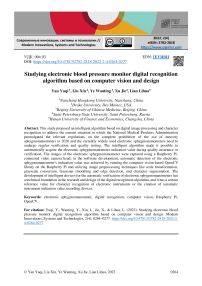Studying electronic blood pressure monitor digital recognition algorithm based on computer vision and design
Автор: Yan Yuqi, Ye Wanting, Liu Xin, Xu Jie, Lian Lihua
Журнал: Современные инновации, системы и технологии.
Рубрика: Управление, вычислительная техника и информатика
Статья в выпуске: 2 (4), 2022 года.
Бесплатный доступ
This study proposed an intelligent algorithm based on digital image processing and character recognition to address the current situation in which the National Medical Products Administration promulgated the relevant regulations on the complete prohibition of the use of mercury sphygmomanometers in 2020 and the currently widely used electronic sphygmomanometers need to undergo regular verification and quality testing. The intelligent algorithm made it possible to automatically acquire the electronic sphygmomanometer indication value during quality assurance or verification. The images of the electronic sphygmomanometer were captured using a Raspberry Pi-connected video camera head; in the software development, automatic detection of the electronic sphygmomanometer's indication value was achieved by running the computer vision-based OpenCV library on the Raspberry Pi and utilizing image preprocessing techniques like scale transformation, grayscale conversion, Gaussian smoothing and edge detection, and character segmentation. The development of intelligent devices for the automatic verification of electronic sphygmomanometers has a technical foundation in the research and design of the digital recognition algorithm, and it has a certain reference value for character recognition of electronic instruments or the creation of automatic instrument indication value recording devices.
Electronic sphygmomanometer, Digital recognition, Computer vision, Raspberry Pi, OpenCV
Короткий адрес: https://sciup.org/14124893
IDR: 14124893 | УДК: 004.93 | DOI: 10.47813/2782-2818-2022-2-4-0264-0277
Текст статьи Studying electronic blood pressure monitor digital recognition algorithm based on computer vision and design
DOI:
Blood pressure is an important human physiological parameter that is often used in the clinical diagnosis of various diseases. Currently, the most widely the most widely used blood pressure measuring instruments in medical institutions are mercury sphygmomanometers and electronic sphygmomanometers. On October 14, 2020, the State Drug Administration issued a document stating that From January 1, 2026, China will completely ban the production of mercury-containing thermometers and sphygmomanometers [1]. With the gradual implementation of the mercury ban policy, the electric with the gradual implementation of the mercury ban, electronic sphygmomanometers will be a mandatory replacement for mercury sphygmomanometers. Electronic sphygmomanometers are simple to operate, intuitive to measure, and have advantages such as self-service blood pressure measurement and memory storage. However, there are literature and industry analyses show that electronic sphygmomanometers have high errors and need to be regularly.
Thus, it is necessary to automatically detect the electronic blood pressure in a correct manner. Therefore, it is necessary to automatically identify the measurement values of electronic sphygmomanometers during the calibration or quality control process in order to improve and avoid errors and omissions caused by manual recording [2-4]. The research direction is currently focused on computer vision refers to the use of image processing, pattern recognition, human. The computer vision refers to the use of artificial intelligence and other technologies to replace the human eye for target recognition, tracking, measurement to replace the human eye to recognize, track, measure, and perceive, identify, and understand the objective world. Eventually, it is process of implementing human vision functions on a computer platform. Currently computer vision technology has been widely used in the fields that require manual recognition. The advantages are high accuracy, high speed, and avoidance of recording errors caused by human errors. In this context, this study designs a computer vision-based digital recognition algorithm for electronic blood pressure monitors [5-8].
HARDWARE PLATFORM AND SOFTWARE FOUNDATION
When choosing a hardware platform, the system's functionality of the ARM-Linux operating system is the basis for the design. The Raspberry Pi with its ARM-Linux operating system has been chosen for this design. This design uses the Raspberry Pi (Raspberry Pi), which runs the ARM-Linux operating system. The driver and application are created on the Raspberry
Pi to obtain the image of the electronic blood pressure monitor. Using Raspberry Pi, and by designing the driver and application on the Raspberry Pi to obtain the image of the electronic
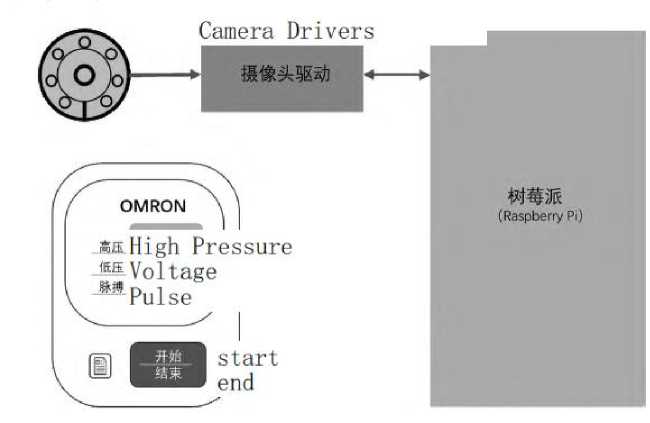
blood pressure monitor [9-11], it was possible to realize the image acquisition of the electronic Figure 1 . Schematic of the hardware platform of the Raspberry Pi-based system.
sphygmomanometer display value. The complete hardware acquisition system is shown in figure 1.
This design chooses the Python-based OpenCV computer vision library for the software development environment. OpenCV is a computer vision library written in Python. The digital character recognition of the captured images is made possible by using intelligent recognition algorithms and digital image processing technology.
Algorithm Implementation
By transforming, noise reduction, and noise reduction to reduce the useless information in the image, remove the noise in the image noise, and highlight data features for edge detection [11-14], feature extraction, image segmentation, and character recognition, the digital image processing aims to reduce the useless information in the image are used. In order to perform edge detection, feature extraction, image segmentation, and character recognition later, digital image processing reduces the image's unnecessary information, removes image noise, and highlights the features of the data image. Figure 2 illustrates the process of character segmentation recognition and image processing.
|
Image Acquisition |
— ► |
Scale change |
1 1 Grayscale transformation 1_________________________________________________________________1 |
Gaussian smoothing |
|
1 |
||||
|
Edge detection |
— ► |
Character cutting |
—Segment code —> identification 11 |
Character classification 1 |
Figure 2. Image processing and character segmentation recognition flow chart.
Image pre-processing
Image preprocessing consists of scale transformation, grayscale conversion, Gaussian smoothing sliding and edge detection. The preprocessing can reduce the computational effort of image processing and remove the noise in the image, which reduces the complexity for the subsequent character. The preprocessing reduces the computational effort of image processing and removes the noise in the image [15-18], which reduces the complexity and provides more accurate input images for subsequent character segmentation recognition.
Scale change. The Raspberry Pi acquires images with a resolution of 1,280 × 1,024 and performs real-time image analysis processing, which is computationally intensive. In order to reduce the Raspberry Pi is a real-time image analysis process, which is computationally intensive [19-22]. The captured image is compressed and transformed to 640×512, and the data processing volume is 1/100th of that before compression. The amount of data processing is 1/4 of that before compression, and the scale transformed image is shown in figure 3a.
Grayscale conversion. The Raspberry Pi's camera can capture color images, and because each pixel is made up of three different colors — R, G, and B — each of which has 255 magnitudes, each pixel has a color variation range of more than 16 million (255255255). The R, G, and B components are mapped between 0 and 255 using a special algorithm known as the grayscale transform, which can significantly lessen the processor's computational load. The component method, maximum method, average method, and weighted average method are currently the most popular grayscale transformation techniques [23-26]. This design uses the weighted average method to process images into grayscale, which is represented in figure 3b by the code cv2.cvtColor(image,cv2.COLOR BGR2GRAY).
Gaussian smoothing. In image processing, gaussian smoothing is frequently utilized for noise reduction and the avoidance of the goal of Gaussian smoothing is to create a flat image by using the nonlinear low-pass noise in the image signal. The goal of Gaussian smoothing is to produce a flat [27-31], gradual image with less noise by using a Gaussian filter to remove noise from the image signal [9]. A 55 Gaussian filter was used in this design to apply the Gaussian smoothing. Figure 3c illustrates the filtered effect.
Edge detection. An edge is a local area of an image where the pixel set has undergone a stepwise grayscale transformation. Grayscale values in the same region are typically more evenly distributed than those in other regions, which are somewhat dispersed across regions [32]. This property allows us to obtain the LCD border line of the sphygmomanometer for later analysis. This design utilizes an edge detection operator that is Canny algorithm optimized, which has good noise immunity and can detect edges with accuracy. Figure 3d displays the edges that were discovered.
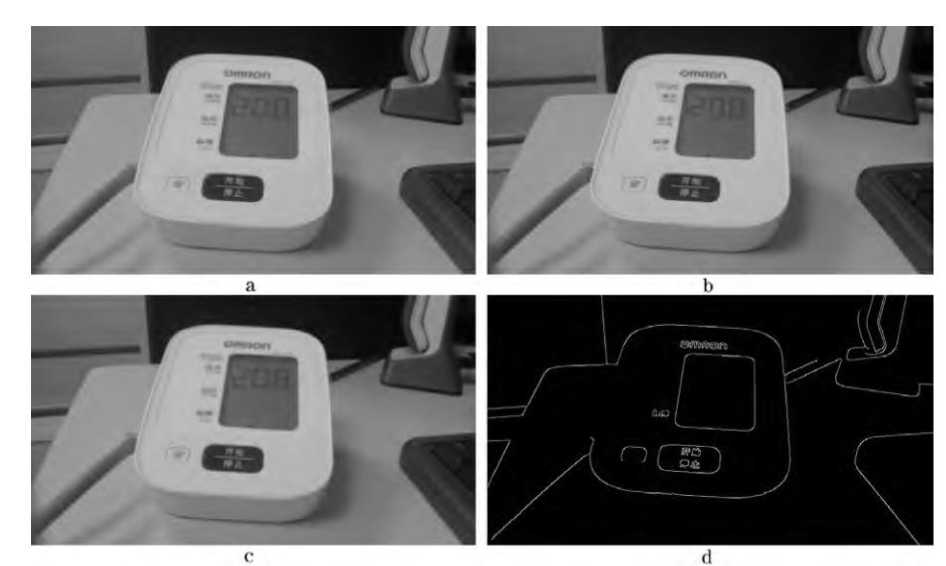
Figure 3. The effect of each stage after treatment: a:Scale change,b:Grayscale conversion,c:Gaussian smoothing,d:Edge detection.
Additionally, researchers are evaluating additional models and techniques for predicting stock values. As more data sets and more hardware become accessible, deep learning continues to improve. This has resulted in significant advancements in disciplines such as image recognition [33], speech recognition, and natural language processing.
Character segmentation
The region of interest, the largest rectangular area in the figure, which is the data area displayed on the LCD screen area, was obtained through image preprocessing. Since the Raspberry Pi camera's shooting angle cannot be adjusted automatically Since the LCD display is not always a front view, we use It is for this reason that we use the four-point transform function of the imutils library's perspective transformation to correct the image [34].
The character contours on the image above were retrieved using the imutils library's grab contours function after using cv2.findContours to correct the character data in the LCD area. The contours are stored in the grab contours of the imutils library to facilitate character recognition. The effect of character segmentation is shown in figure 4.
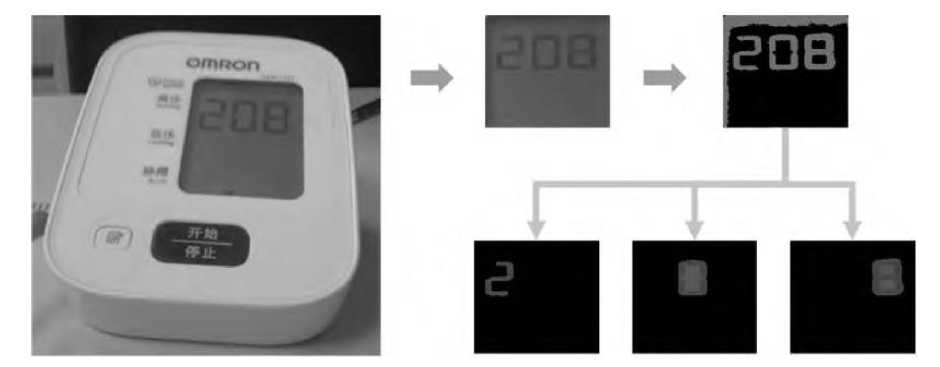
Figure 4. The effect of character segmentation.
Segment code identification
The electronic blood pressure monitor's value is made up of a combination of seven LCD segment codes. We designed a unique right-angle coordinate system model for the seven segments in order to achieve precise segment recognition. A unique right-angle coordinate system model is made for each of the seven segments in order to achieve accurate segment recognition, and figure 5 details the important character positions. For instance, the image is binarized by 0 and 1 and the a-segment code corresponds to the rectangular region from (0,0) to (w,dh). Binarization of the image into 0 and 1.
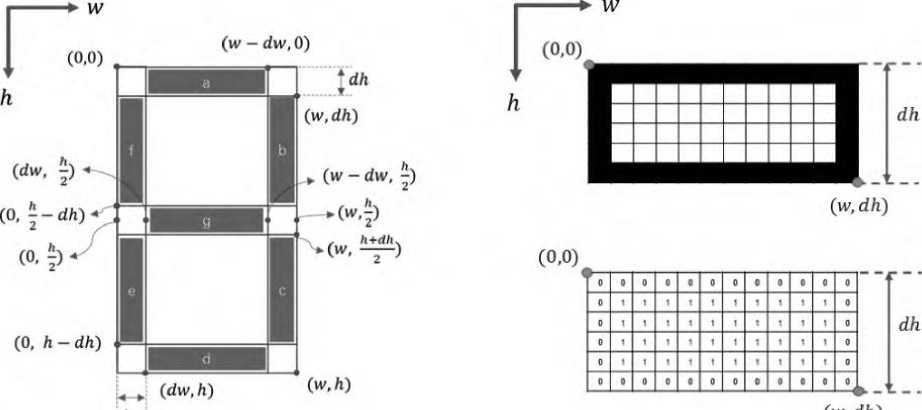
Figure 5. Liquid crystal segment code model and coordinate system description.
The number of white dots in the rectangular area can be counted to determine whether the a-segment code is lit or not. All that is required is the number of white dots in the rectangle. In formula (1), the criterion f(a) is provided for segment a, taking into account that the image will produce edge effects due to the Gaussian blurring. We increase f(a) by the calibration factor, which is 0.65. It is thought that the white point in the rectangle, which makes up more than 65% of the segment code point, is bright. Using the method outlined above [35], we can calibrate the segments b, c, d, e, f, and g one at a time.
0 f(a) = {
^ i dh
1 =0 1 > xtj
^ j=0dh
1 =0 1) X tj
2—1 j = 0
< (w + 1) x (dh + 1) x A
(A = 0.65)
> (w + 1) x (dh + 1) x A
( 1 )
Character classification
The process of character classification involves figuring out what the number that the current character represents means. The action of the segment code recognition result is compared with the segment code array, and when the two are identical, the character is identified as the current character. By evaluating the criterion f, we can determine the corresponding 0 or 1 for each segment. The character will be categorized as the number of the current character when the two are identical. The character is then classified as the current number, i.e., the character classification is finished [35-38], when the segment code recognition result and the segment code array are identical.
The segment code light-up/light-down relationship is shown in figure 6.
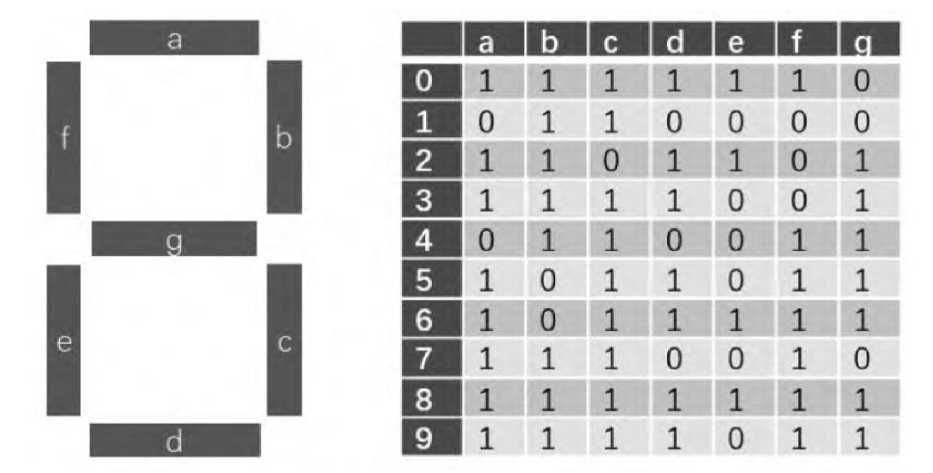
Figure 6. Seven segment characters and segment code encoding rules.
PRACTICAL APPLICATIONS
Using the hardware platform of the Raspberry Pi 4B (ARM Cortex-A72 quad-core 1.5 GHz, RAM: 8 GB LPDDR4), we measured the precision of the character recognition algorithm. To finally achieve the automatic recognition of 2, we used the pre-processing method and the recognition algorithm described in the preceding section.
The 2-bit width and 3-bit width characters were automatically recognized using the preprocessing procedure and recognition algorithm discussed in the previous section. The findings show that this method can be applied to determine the value of an electronic sphygmomanometer. The findings demonstrate that the electronic sphygmomanometer's value can be determined using this method [39-42], the positioning area is precise, and the results of the character recognition is show that this method can be used to identify the value of the electronic sphygmomanometer with precise area definition and character recognition.

Figure 7. Automatic recognition of results.
CONCLUSION
For the current electronic sphygmomanometer calibration and quality inspection the problem of manual recording of the displayed value and the inability to automate the testing and recording is solved. This study proposes an automatic recognition algorithm based on image processing. It is algorithm based on image processing, by systematically introducing the digital image processing of electronic sphygmomanometer. Proposed algorithm is based on image processing by systematically introducing the digital image processing of electronic sphygmomanometer and performing scale transformation, grayscale conversion, Gaussian smoothing Canny edge detection, character segmentation, segment code recognition, character classification, and so on [43-46].
The entire design is implemented on Raspberry Pi 4B using the OpenCV library, and finally the method is experimentally proven to be accurate in positioning and recognition. The implementation of this technique can solve the problem of the current electronics. The implementation of this technology can solve the current electronic blood pressure meter inspection workload The implementation of this technology can solve the current problems of large workload of electronic sphygmomanometer inspection, time-consuming and laborious manual recording, and improve the efficiency of inspection or quality testing. In this case, the intelligent image recognition algorithm is used to achieve the accuracy of the calibration or quality inspection. At the same time, the intelligent image recognition algorithm is used to realize the automatic reading and analysis of the calibration results, which avoids errors or errors caused by human factors. At the same time, the intelligent image recognition algorithm is used to achieve automatic reading and analysis of the calibration results, avoiding errors or mistakes caused by human factors [47-49].
In conclusion, we note that the development of intelligent devices for the automatic calibration of electronic blood pressure meters and the character recognition of electronic instrumentation as well as the creation of automated instrumentation display value recording devices has been made possible by the research and design of the digital recognition algorithm.

